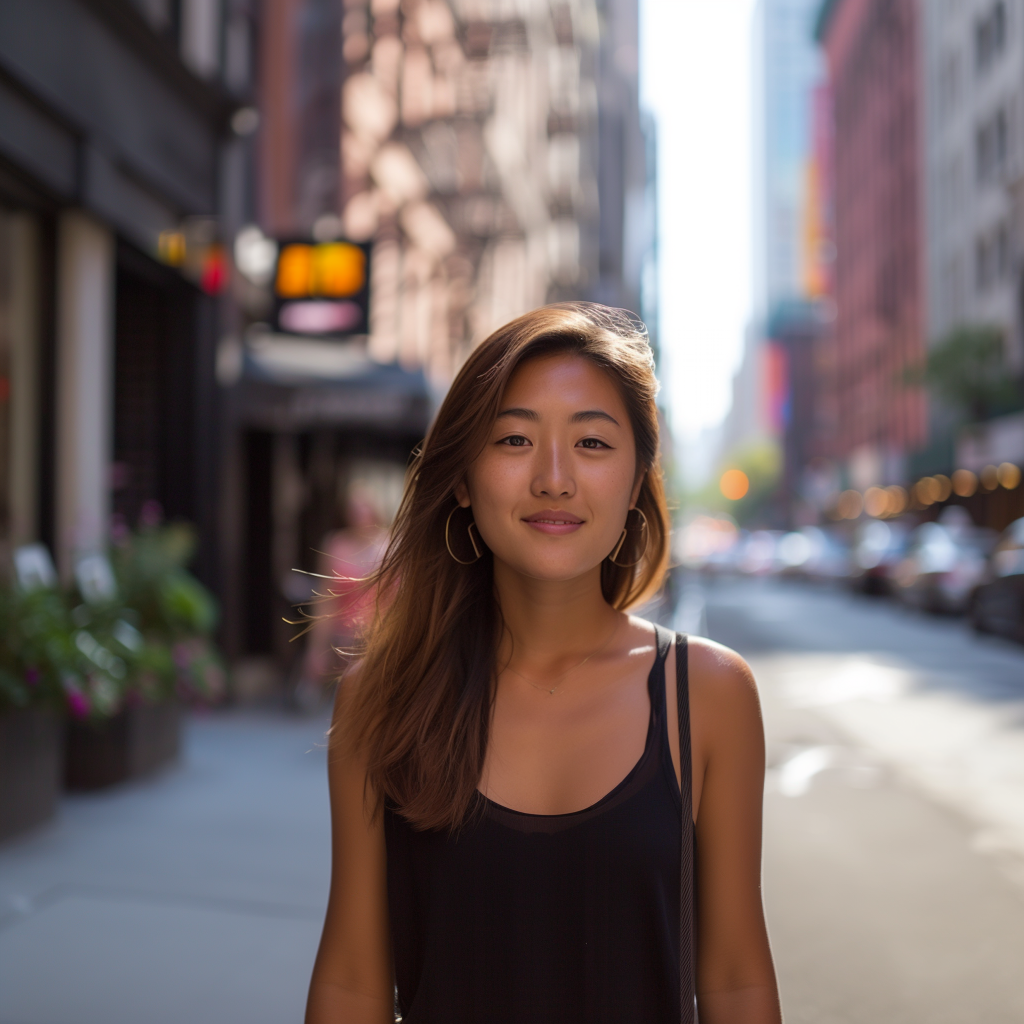Art therapy can help you explore and regulate intense emotions, build self-awareness, and process trauma associated with BPD. Through creative activities like watercolor exercises and symbolic art, you can externalize feelings, identify triggers, and develop healthier responses. Using colors and imagery, you’ll gain insight into your emotional states and build resilience. Incorporating art therapy into your treatment plan can be a safe, non-verbal way to understand yourself better—keep going to discover how it all works together.
Key Takeaways
- Art therapy offers non-verbal emotional exploration, externalizing internal experiences to improve emotional awareness in BPD.
- Techniques like watercolor and symbolic art help visualize complex feelings and regulate mood fluctuations.
- Incorporating art therapy within trauma-informed, structured interventions enhances emotional regulation and reduces maladaptive behaviors.
- Visual self-exploration fosters self-awareness, reduces feelings of emptiness, and supports identity formation in BPD clients.
- Collaboration with multidisciplinary teams maximizes the benefits of art therapy in comprehensive BPD treatment plans.
Understanding Borderline Personality Disorder and Its Challenges
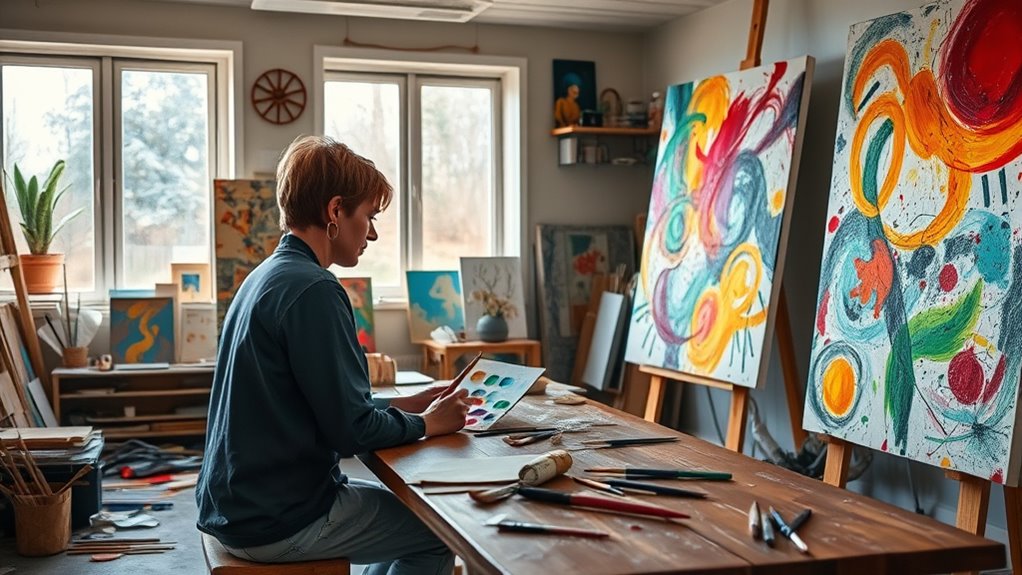
What exactly is Borderline Personality Disorder (BPD), and why does it pose such challenges? BPD is a mental health condition marked by intense emotional reactions, unstable relationships, and a distorted self-image. You may find it hard to regulate your emotions, leading to impulsive actions and chaotic life patterns. Trauma, childhood attachment issues, and invalidating environments often play a role in developing BPD, affecting how you see yourself and connect with others. A diverse range of cuisine options in some settings reflects the complex and multifaceted nature of the disorder. Common symptoms include a fear of abandonment, mood swings lasting hours or days, and self-harming behaviors. These difficulties can create significant psychosocial impairment. Understanding BPD requires recognizing how emotional regulation struggles, trauma, and attachment issues intertwine, making therapy essential for addressing these core challenges and fostering stability and self-awareness. Additionally, emotional dysregulation is a hallmark feature that significantly impacts daily functioning and relationships, and recent research suggests that integrating evidence-based therapies can improve treatment outcomes. Recognizing the importance of individualized treatment plans is vital for addressing the unique needs of each person with BPD. Research indicates that therapeutic approaches tailored to personal experiences can be particularly effective in managing symptoms and improving quality of life.
How Art Therapy Supports Emotional Awareness and Regulation
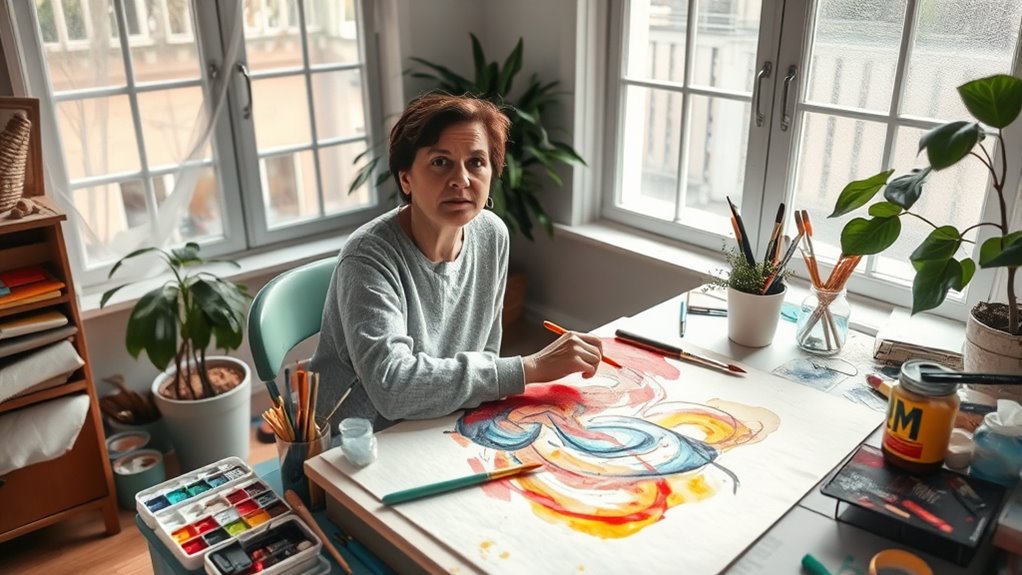
Art therapy offers a powerful way for individuals with BPD to explore and understand their emotions without relying solely on words. Through engaging in visual art, you externalize internal experiences, making complex feelings more tangible. A structured art therapy environment can also incorporate techniques that promote emotional regulation, helping manage intense emotional responses. This creative process helps boost emotional awareness, allowing you to recognize patterns and triggers more clearly. Additionally, the vibrational energy generated during art-making can influence emotional states, fostering a calming effect. The tactile and sensory aspects of art-making activate pathways involved in emotional regulation, encouraging calming responses and reducing impulsivity. Research into sound healing science suggests that the vibrations produced can further support emotional balance and well-being. Incorporating art therapy into treatment can also provide a safe space to process trauma and build resilience. Moreover, understanding the neuroscience of emotion reveals how engaging in creative activities can positively impact brain functions related to mood regulation.
Practical Art Exercises to Explore Internal Experiences
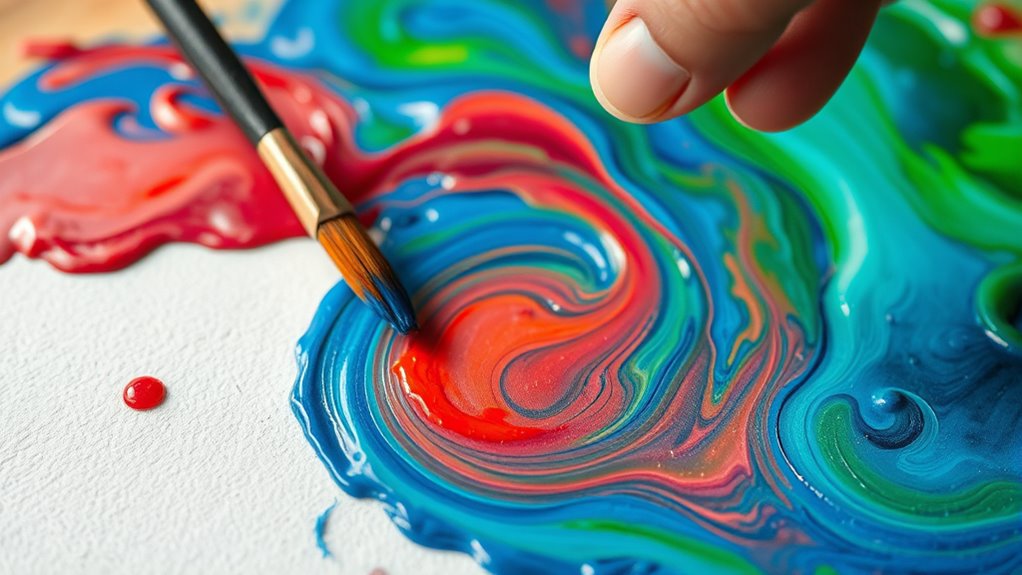
Practicing watercolor exercises allows you to express and observe your internal emotions safely, especially through the interaction of water and pigment that can mirror chaos or calm. The fluid nature of watercolors can also serve as a market indicator, reflecting the dynamic shifts in your emotional state. Your color choices reveal how you feel and can help you understand the connection between your emotions and decisions. Using symbolic art tasks, you can explore your inner world more deeply while developing emotional awareness and regulation skills. Incorporating techniques from Kia Tuning such as customizing your approach can further personalize your art therapy process and enhance your emotional exploration. Additionally, exploring different solar panel technologies in your art projects can symbolize your evolving understanding of sustainable and adaptive coping strategies. Exploring various art mediums can also expand your expressive options, providing new avenues for emotional discovery and emphasizing the importance of emotional awareness in therapy.
Watercolor Water and Chaos
Watercolor techniques that manipulate water volume and pigment concentration offer a powerful way to explore internal chaos and control. In art therapy for BPD, these methods symbolize emotional turbulence and stability.
By experimenting with water levels, you can visually express feelings of chaos, emptiness, and the longing for balance within your internal experiences. Consider these exercises:
- Vary water amounts to create unpredictable blending, reflecting impulsivity. Adjusting water levels can help you understand emotional regulation challenges and develop healthier responses.
- Layer different pigment concentrations to mirror fluctuating emotional states.
- Observe how water influences pigment spread, highlighting emotional regulation challenges and the importance of mindful control.
- Reflect on how small changes in water control impact the overall image, fostering mindfulness.
- Using portable camping gear such as lightweight water containers and travel-friendly brushes can facilitate these exercises in outdoor settings, making the process adaptable and accessible.
- Understanding the beach body concept can help you recognize how external factors like water manipulation influence your internal emotional landscape, encouraging mindful engagement with your feelings. Additionally, practicing these techniques can enhance your awareness of your emotional responses and promote resilience. Incorporating mindful art practices into your routine can further support emotional stability and self-awareness.
This process encourages awareness of how external factors like water volume influence your emotional reactions, helping you understand and manage chaos through creative exploration.
Color Choices and Emotions
Choosing colors intentionally during your art exercises can reveal insights into your emotional landscape. In art therapy for BPD, color symbolism helps you explore emotional expression and understand mood regulation. Acknowledging the significance of color choices can also foster greater self-awareness, enhancing your ability to identify and process complex emotions. A new sentence with emotional awareness and the rest of the sentence. Warm colors like red and orange often evoke feelings of anger or passion, highlighting intense emotions. Cool colors such as blue and green promote calmness and may uncover feelings of sadness or emptiness. Bright, vibrant hues can reflect hope and excitement, encouraging positive internal experiences. Conversely, dull or muted colors might indicate emotional numbness or withdrawal, offering clues about suppressed feelings.
Symbolic Art for Self-Exploration
Engaging in symbolic art exercises allows you to explore your internal experiences beyond words, making complex emotions more accessible. This form of self-exploration uses visual representation to uncover hidden feelings and internal states.
You can try:
- Creating layered drawings or collages to externalize emotions like anger or fear.
- Depicting a safe place or emotional storm to visualize internal conflicts.
- Using repetitive activities, like coloring a symbolic image, to deepen emotional regulation.
- Incorporating symbolic themes to process subconscious thoughts safely within art therapy.
These exercises help you access and understand your emotional landscape, fostering insights that promote self-awareness and emotional regulation. Symbolic art becomes a powerful tool for exploring your internal world, encouraging meaningful self-exploration.
Case Insights: Emma’S Journey With Art-Mediated Self-Discovery
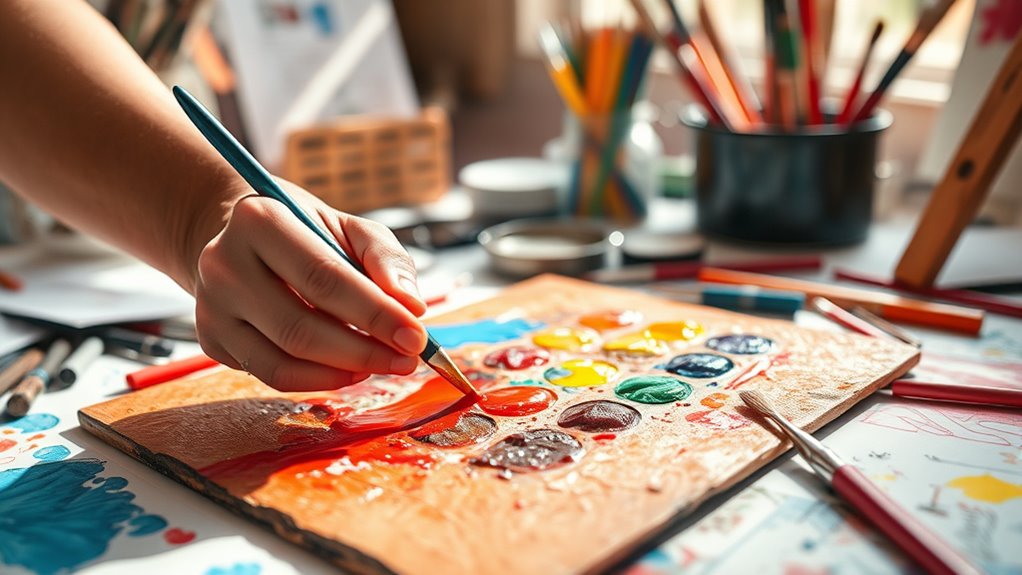
Emma’s experience shows how art therapy can foster emotional regulation and self-identity.
As she works with watercolors, she gains insight into her emotional patterns and learns to manage her reactions.
This process helps her build a stronger sense of self and stability over time.
Emotional Regulation Growth
How can art therapy foster emotional regulation in individuals with BPD? It encourages self-awareness and helps you manage intense feelings. Through art-based reflection, you can explore your emotional patterns and develop skills like distress tolerance.
Emma’s journey highlights these benefits:
- Using watercolor exercises, she observed how controlling water volume symbolized her emotional intensity, promoting relaxation.
- Creating art allowed her to express difficult feelings she couldn’t verbalize, reducing distress.
- Recognizing impulsive reactions through art meditations strengthened her self-control.
- Developing a more stable self-image improved her mood management over time.
This process supports emotional regulation by enhancing self-awareness, providing a safe outlet for feelings, and fostering mental health resilience—key elements in art therapy for BPD.
Self-Identity Exploration
Art therapy serves as a powerful tool for exploring and shaping your self-identity, especially when words fall short. Through art therapy, you can engage in visual self-exploration using various art materials, which helps you externalize internal conflicts and gain insight into your evolving self-identity.
For someone with BPD, this process supports emotional regulation by allowing you to process feelings through creative expression. Emma’s journey exemplifies how watercolor exercises helped her reflect on her decisions and their impact on her emotional stability and self-perception.
Creating art provided her with a clearer understanding of her inner world, reducing feelings of emptiness and fostering a more cohesive, positive self-image. Ultimately, art therapy empowers you to develop greater self-awareness and resilience on your path to self-discovery.
The Role of Creative Expression in Building Self-Identity
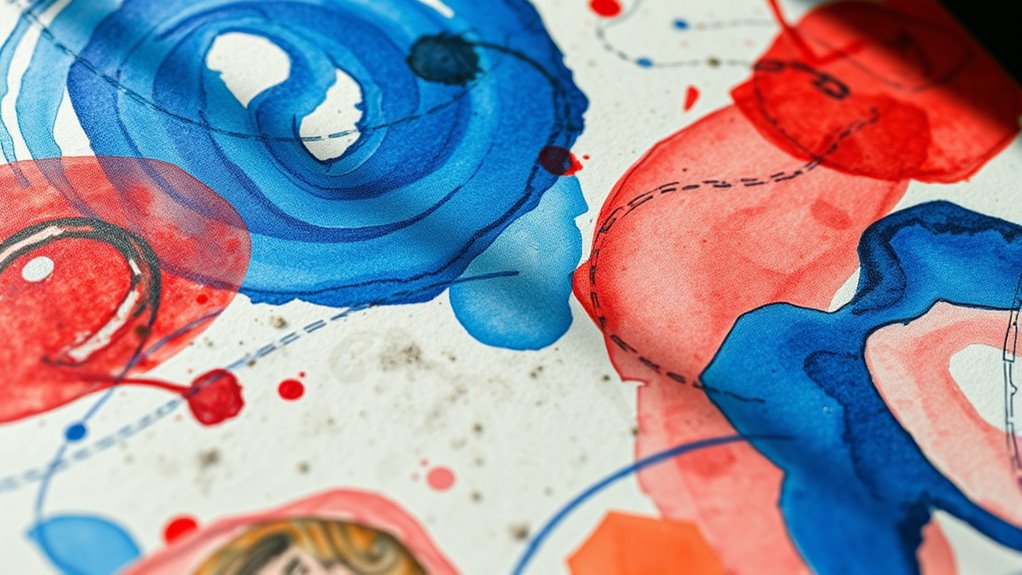
Have you ever considered how creative expression can shape your sense of self? In art therapy, engaging in creative activities helps you externalize internal experiences and emotions, which is crucial for building your self-identity.
Through art-making, you can:
- Visualize personal narratives to understand your inner world better
- Develop self-awareness by exploring different aspects of yourself
- Experiment with various self-states in a safe space
- Foster a cohesive sense of self, leading to a more positive self-image
This process encourages flexibility and integration of your multiple self-states, supporting a stable and authentic identity. Regular creative expression not only deepens your self-understanding but also reduces identity disturbance, helping you feel more grounded and true to yourself.
Implementing Art Therapy in Clinical Settings for BPD

Implementing art therapy in clinical settings for individuals with BPD requires careful integration into existing treatment plans. You’ll want to use structured art interventions that encourage emotional expression and boost self-awareness.
Evidence shows that art therapy can markedly improve emotional regulation, reduce impulsivity, and decrease maladaptive behaviors associated with Borderline Personality Disorder.
Art therapy significantly enhances emotional regulation and reduces maladaptive behaviors in BPD treatment.
To guarantee effective therapy implementation, clinicians should adopt trauma-informed, non-judgmental approaches tailored to each client’s needs. Proper training in art therapy techniques and BPD symptomatology is essential for success.
Embedding art therapy within multidisciplinary teams allows for thorough care, leveraging visual expression to complement verbal psychotherapy.
When carefully integrated, art therapy becomes a powerful tool to help your clients manage emotions and foster stability.
Resources and Tips for Engaging in Art-Based Self-Care
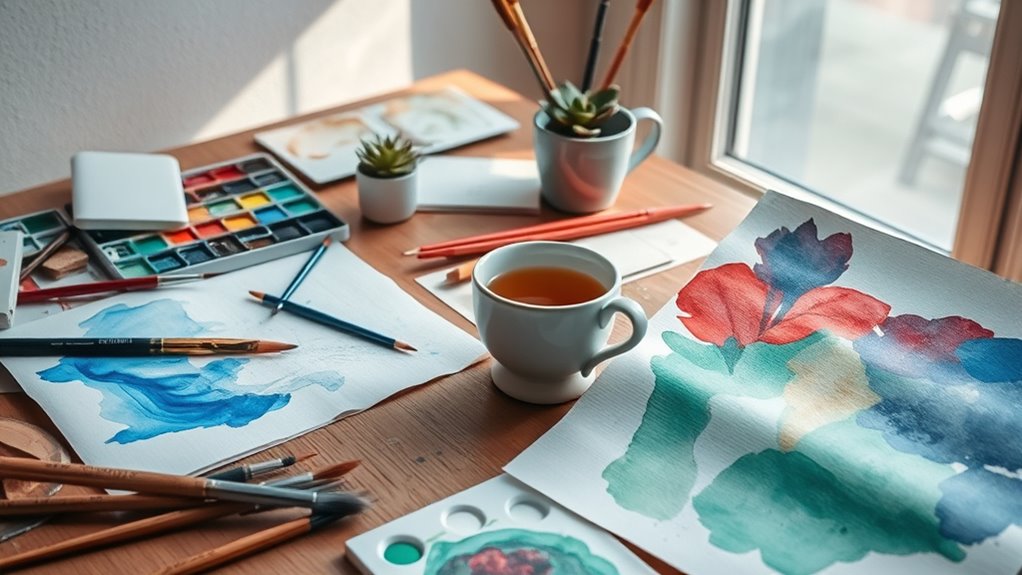
Engaging in art-based self-care offers a powerful way to process intense emotions and foster emotional regulation, especially for those managing BPD. To get started, consider these resources and tips:
- Use simple art materials like watercolors or clay to enhance sensory engagement and promote relaxation.
- Focus on creating art without judgment or expectations to build self-compassion and reduce self-criticism.
- Incorporate reflective practices, such as journaling about your artwork, to deepen personal insight and self-awareness.
- Share your art with a trusted friend or therapist to strengthen connections and gain understanding of your emotional experiences.
These art activities support emotional regulation, reinforce self-care routines, and improve mental health through creative expression and personal growth.
Frequently Asked Questions
Is Art Therapy Good for BPD?
You’re wondering if a certain therapy is effective for BPD. Based on research, engaging in creative activities helps you explore and manage intense emotions better. It promotes self-awareness, reduces feelings of emptiness, and improves your sense of self.
When combined with other treatments like Dialectical Behavior Therapy, it can enhance your overall progress. So, yes, this approach can be a valuable part of your journey toward emotional stability.
What Is the Most Effective Therapy for BPD?
Imagine steering a stormy sea; the most effective therapy is your sturdy lighthouse guiding you safely. Dialectical Behavior Therapy (DBT) stands out as the gold standard, helping you manage intense emotions and build resilience.
It combines skills like mindfulness and distress tolerance, acting as your beacon through turbulent times. While other therapies offer valuable tools, DBT’s structured approach provides the strongest foundation for overcoming Borderline Personality Disorder.
What Are the 3 C’s of BPD?
You’re asking about the 3 C’s of BPD. These are Fear of Abandonment, Unstable and Intense Relationships, and Identity Disturbance.
They represent core issues like feeling insecure about being left, struggling with fluctuating relationships, and having an unstable sense of self.
Recognizing these helps you understand the key challenges faced in BPD, guiding you toward targeted therapy and support to manage these difficult patterns more effectively.
Did Angelina Jolie Have BPD?
You might wonder if Angelina Jolie has BPD, but there’s no confirmed evidence. While media speculates about her emotional struggles and intense relationships, she hasn’t publicly disclosed a diagnosis.
You should remember that mental health details are personal, and without official confirmation, it’s just speculation. Jolie has openly sought therapy for her trauma and challenges, but attributing a specific disorder like BPD remains unfounded without verified medical information.
Conclusion
Embracing art therapy for BPD is like planting seeds in a garden—you nurture growth, healing, and self-discovery. By engaging in creative expression, you access feelings and build resilience step by step. Remember, your journey is unique, and each brushstroke or scribble brings you closer to understanding yourself better. Keep exploring, stay patient, and let your creativity be the guiding light through the ups and downs of your path to wellness.
Isla’s writings reflect a profound connection to the BPD community, offering solace and understanding to those who feel isolated by their struggles. Her articles explore the nuances of relationships, healing, and self-discovery, all through the lens of BPD. Isla’s compassionate approach to storytelling encourages readers to embrace their journey with hope and resilience.

